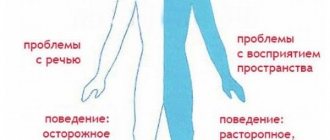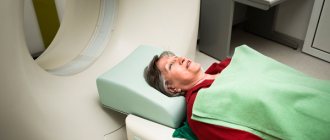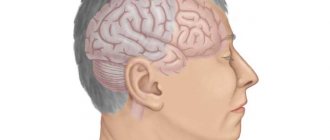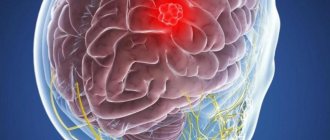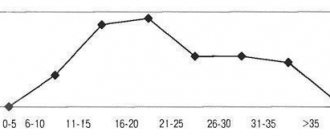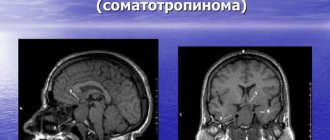But only surgery can prolong the life of a person suffering from a disease such as a brain tumor.
Our consultant is Candidate of Medical Sciences, Head of the Department of Neurosurgery of the Russian Scientific Center for Surgery of the Russian Academy of Medical Sciences. B.V.Petrovsky Sergey Vasiliev .
Unfortunately, any neoplasms that arise in the brain pose a serious threat to human life, and therefore can be considered benign or malignant rather conditionally. Even if the cellular composition of the tumor itself, from an oncological point of view, does not inspire concern, its potential harm is very great.
The fact is that any neoplasms that develop in a confined space of the skull lead to an increase in intracranial pressure and sooner or later lead to the death of the patient. In addition, even a benign brain tumor can develop into a malignant tumor over time.
State of a person with illness
A brain tumor is an oncological disease, very dangerous and insidious. It is this disease that most often leads to death. At the initial stage of the disease, headaches are very similar to the symptoms of migraine. Therefore, this does not alarm people, and they refrain from going to a specialist. But there are still symptoms that distinguish a growing tumor.
Leading experts in this field describe how a headache with a brain tumor hurts. These are the accompanying symptoms:
- When the tumor increases in size. It compresses the nerve endings and this is accompanied by pain. At the onset of the disease, headaches appear and disappear throughout the day. But with development, these sensations become permanent.
- In old age, people with this disease have mental disorders and are often unaware of what is happening around them.
Main symptoms
It is imperative to contact a medical facility if the following symptoms are noted:
- A person sleeps for a long time, and after waking up he cannot concentrate and realize what is happening around him.
- The whole day is accompanied by a throbbing headache.
- Headaches can appear with a sudden change in body position.
- Later stages are accompanied by double vision and numbness in the arms and legs.
- Unreasonable attacks of nausea and even vomiting occur.
- Speech begins to become confused.
- Movements become uncontrollable, speech is incoherent. The person may lose consciousness.
- Headache due to brain tumor does not go away. Painkillers do not help, and the pain intensifies when coughing and blowing the nose.
Diagnostics
All these symptoms should alert you, and they are a reason to urgently contact the clinic to receive a referral for an MRI. A computed tomography scan will allow you to exclude or confirm suspicions of a cancerous tumor. There should be no self-medication. Only an experienced doctor, after conducting a number of examinations and tests, is able to make the correct diagnosis. The patient, studying his condition, must follow all the doctor’s recommendations and prescriptions in order to prevent further development of the tumor process.
The tumor can be localized in any part of the brain. And each zone is responsible for certain human conditions.
For example, the frontal part of the brain regulates people's ability to behave differently in life situations, such as the ability to walk or stand. In a word, for coordination of movements and the ability to think. If the tumor affects this area, the person's perception and personality may completely change. If symptoms such as loss of coordination, loss of taste and smell appear, mood changes sharply and headaches are tormented, you should immediately contact a neurologist.
Throbbing pain in the temples, epileptic seizures, strange visions and unreasonable fear, as well as loss of taste and vision are signs of the development of a malignant tumor in the temporal region of the brain. When it grows, it puts pressure on the optic nerves and can lead to blindness.
When the tumor affects the parietal region, the largest part of the brain, headaches intensify and all other symptoms may become more intense. A tumor in the lower part can lead to loss of sensation in the head and to cramps, in which the muscles of the face, arms and legs twitch. A tumor in the superior parietal lobe leads to muscle atrophy; with epilepsy, the part of the face on the side opposite to the tumor begins to twitch. If a tumor is allowed to develop, it can lead to a tragic end.
Dexamethasone for brain tumors
Principles of pathology classification
A brain tumor can manifest itself in two forms:
- primary – grows from cells of intracranial tissues;
- secondary - appears against the background of metastasis of the cancer process of other internal organs.
Depending on the structure of the head tumor, oncologists distinguish the following types:
- neuroepithelial – the nature of the manifestation is different. Often appears from brain tissue. What are the prerequisites for its development? Risk factors include glioma, epindymoma, astrocytoma;
- meningeal – grows from meningeal tissues. The pathology is manifested by meningioma;
- pituitary adenoma;
- cranial – the benign nature of the process is often diagnosed;
- dysembryogenetic – generated by embryogenesis;
- metastatic - to find out where the tumor is located, an MRI may be indicated. The pathological process develops outside the skull.
Types of headaches
By nature of manifestation:
- pressing
- bursting
- pulsating
- stupid
- beam (cluster)
- scattered (diffuse)
According to accompanying symptoms:
- nausea not caused by indigestion
- dizziness, loss of consciousness
- increase in body temperature
- sweating
- shortness of breath, rapid heartbeat
- hallucinations
There are primary tumors that develop from brain tissue and adjacent formations. These are neuroepithelial (glioma, astrocytoma), meningeal tumors (meningioma), pituitary tumors (adenoma) and cranial nerve tumors (neurinoma). Primary tumors can be either benign or malignant.
In addition, malignant neoplasms of other tissues and organs can metastasize (drop out) tumors into the brain. Such lesions are called secondary.
The location depends on the type of tumor; this is taken into account when making a preliminary diagnosis. Astrocytomas, for example, are most often located in the cerebellum or cerebral hemispheres, gliomas - in the temporal or frontal lobe, meningiomas are formed in the area of the sella turcica, olfactory fossa and parietal region, neuromas affect the auditory and trigeminal nerve.
How to distinguish tumor pain from other types of pain
The nature of headaches with brain tumors differs from other types of pain. To distinguish cancer pain from other diseases, you need to know the symptoms of these diseases.
- For example, migraines have very similar symptoms to headaches associated with brain cancer. The pain is severe, paroxysmal, and can last up to several days. Nausea and photophobia may also occur.
- Many people know firsthand what kind of headaches a person experiences from tension. These are paroxysmal pains that appear either in the frontal part or the occipital part. They can be long or very short, but have a strong effect on mood, causing depression and weakness.
- With hypertension, the pain is short, moderate in nature, localized in the occipital or parietal region. As pressure increases, they increase and can lead to dizziness, nausea and weakness.
- Paroxysmal cluster pains are very strong. As a rule, they are felt in the area of the nose, eyes and eyebrows. They are accompanied by watery eyes and sinus congestion on one side of the nose. The pain may recur periodically.
- Cervicogenic pain is distinguished by the fact that it is accompanied by tinnitus and numbness of the neck muscles. These are paroxysmal pains on both sides of the head that are paroxysmal in nature.
When is a visit to the doctor necessary?
For any manifestation of pain in the head, it is advisable not to delay the visit to the doctor. But this is especially true for pain that has a certain character. And so, if pain occurs at night or immediately after waking up, or is present all day, and by the evening the painful sensations disappear, then this may indicate the development of a tumor.
You cannot ignore pain that has arisen for the first time, but is intense, sharp in nature, as well as frequent pain, with accompanying symptoms in the form of vomiting, impaired motor function, convulsions, deterioration of vision, memory, and mental abilities.
Consultation with a specialist and appropriate examination are also required for headaches that occur during physical activity, even minimal ones.
There is a pain syndrome in the head area, accompanied by heaviness in the cervical region and an increase in temperature. The peculiarity is that when the pain disappears, the temperature also returns to normal. Such situations also require medical consultation and appropriate examination.
Seeking medical help
Headaches do not appear on their own. Any serious illness begins with various symptoms for which you need to consult a doctor.
These include:
- constant pain in the head, varying in location and intensity;
- unexpected pain in all parts of the body;
- migraine that does not go away after three days.
If a headache occurs, you need to contact a neurologist, who diagnoses and identifies the causes of these pains. The neurologist checks reflexes, hearing, coordination of movements, and tactile sensitivity. If necessary, he may prescribe an x-ray to identify tissue calcification that forms in the presence of tumor processes.
Electroencephalography is necessary to identify any abnormalities in the functioning of the brain.
Rheoencephalography is intended for diagnosing cerebral vessels. Thermography shows the temperature in different areas of the head, identifying the cause of pain. MRI or magnetic resonance examination, tomography is performed to determine whether there is a tumor, to determine its size and location. You can find out the cause of the tumor. If the examination reveals the presence of a neoplasm, the patient is sent to the neurosurgery department for further examination and treatment.
Cancer Prevention
As a preventative measure, doctors recommend not to overuse salt. If a tumor has already formed, then you should completely avoid beans, peas, beans, and all fermented milk products. If headaches occur frequently due to brain cancer, then a certain regimen should be developed. Rest more often, try to talk less. Massage and warm foot baths will help.
Treatment with folk remedies in such cases is undesirable, but as a preventative measure, taking herbal remedies is recommended. The most famous in the fight against the formation of cancer cells are chaga, lemon balm, hemlock, peppermint, oregano, clover, and horsetail.
But self-medication is impractical and dangerous. Therefore, it is recommended to contact experienced specialists with all questions.
The key to success in treating such a dangerous disease as cancer is timely consultation with a doctor.
Treatment
As for treatment, the only way to get rid of a brain tumor is through surgery. Having previously determined the size of the tumor and its location, the surgeon removes it completely. As an alternative, radiosurgery can be used - a completely painless method.
It happens that the tumor cannot be removed surgically, and then radiation therapy is used, which “kills” the cancer cells that contribute to the development of the disease.
There is another method - chemotherapy. This is a very effective drug treatment for malignant brain tumors. Medicines are administered intravenously and, once they enter the bloodstream, they destroy all foci of cancer.
As additional therapy, the doctor prescribes painkillers, vitamin preparations, and medications to relieve swelling.
In addition, the doctor prescribes various physical procedures, taking into account the individual characteristics and development of the patient’s disease. These include:
- Inductothermy. This is the effect on the affected area of a magnetic field of high frequency wave oscillations.
- Phonophoresis and ultrasound therapy. The effect of ultrasonic waves on the patient's body.
- Laser therapy. The effect of laser beams on the human body, as a result of which metabolism is normalized, promoting rapid healing and regeneration of cells in areas of affected tissue.
- Electrical stimulation. To stimulate muscle tissue and the nervous system, current pulses are sent to specific points.
- Electrophoresis. In order for medications to be absorbed by the body faster, they are administered under the influence of current.
The causes of headaches are:
- Oncology, including brain cancer headache, spinal cord tumors, pituitary tumor, nasopharyngeal cancer, and brain lymphoma.
- Other types of cancer that have metastasized to the brain, such as breast cancer, lung cancer, or melanoma.
- Infections such as sinusitis and meningitis.
- Certain chemotherapy drugs, such as fluorouracil (5-FU), procarbazine (Matulane), and temozolomide (Temodar).
- Other drugs, such as some antibiotics and heart medications.
- Radiation therapy to large areas of the brain.
- Biologic treatments (use substances produced in your body or created in a laboratory to support or stimulate the body's own immune system to fight cancer), including monoclonal antibody therapy, colony-stimulating factors, and interferons.
- Other conditions or symptoms associated with cancer or cancer treatment, such as anemia, hypercalcemia, thrombocytopenia, and dehydration caused by severe vomiting. Stress, fatigue, anxiety, insomnia, undoubtedly all of these factors can lead to an increase in primary headaches such as migraines and tension headaches.
The cavity inside the skull is a closed space. During tumor growth and development:
- intracranial pressure increases,
- the membranes of the brain are compressed,
- the ventricular walls are stretched,
- the trunk of large vessels is compressed,
- pain appears.

